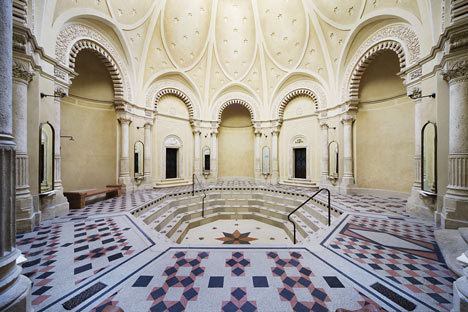 | ||
Similar Rudas Baths, Király Baths, Gellért Baths, Szent Lukács Gyógyfürdő, Lukács Baths | ||
The Rác Thermal Bath, located in Budapest, Hungary, is an 8000-square metre bath and is renowned for its Turkish Bath dating back to the 16th century and also its Imperial pools and Shower Corridor built in the age of the Austro-Hungarian Monarchy. The bath is listed as a UNESCO World Heritage and is now part of the newly built complex of the Rac Hotel & Thermal Spa. It's name derives from the Hungarian name of Serbs, former cohabiting population in Tabán.
Contents
History
Turkish Bath
The oldest part of the Rác Bath is the Turkish Cupola, built in 1572, which was called Kücsük Ilica (Small Thermal) at the time. This cupola remained in a very good state through the centuries and therefore could be authentically restored. The windows, reveals, kurnas (marble basins on the walls), the pool and the floor are still the original ones perfectly renovated to their authentic state thus it looks and can be used like back in the 16th century. The side cupola adjacent to it was destroyed in 1905 which has also been restored according to its remains found by the archeologists.
Ybl Baths and Shower Corridor
The most impressive part of the Rác Bath was constructed and built by Miklós Ybl in two phases between 1865 and 1870. Approximately 30-40 per cent of the romantic Ybl Cupola and the famous Shower Corridor (1865) remained since it was subject to the Russian bomb attacks of World War II, renovation in the 1960s and also in 2002. The rest of this area was rebuilt and restored to its exact original state according to old copper engravings, drawings and documentations.
The second, Imperial Cupola, built in 1870, shows changes in the architect’s perspective. Marble is the main material used and several symbolic elements of the age’s modernity can be found on the walls. This part was completely destroyed during the construction of the Elizabeth Bridge however the pieces demolished were buried into the pool and later provided essential information for the current reconstruction.
Flora Bath
This section of the Rác Spa, also built in 1865, was styled after the ancient Roman Baths which, and now serves as the dedicated VIP section of the complex.
Modern Day Spa
The last part of the Bath was built adjacent to the historical buildings in the 21st century and accommodates the latest treatments and services with 21 treatment rooms, a business room and a special VIP area.
Water content
The many medical benefits of the Rác Bath's karst water are well known. The water contains calcium, magnesium, hydrogen-carbonate, sulphate-chloride, sodium and fluoride ions. The water together with the services provided offer recreation and are claimed to be beneficial for arthritis, spine illnesses, intervertebral disk pains, aortic stenosis, circulatory problems asthma and bronchitis. The complex has 11 pools. Water temperatures are 14˚C, 36˚C, 38˚C, 42˚C.
